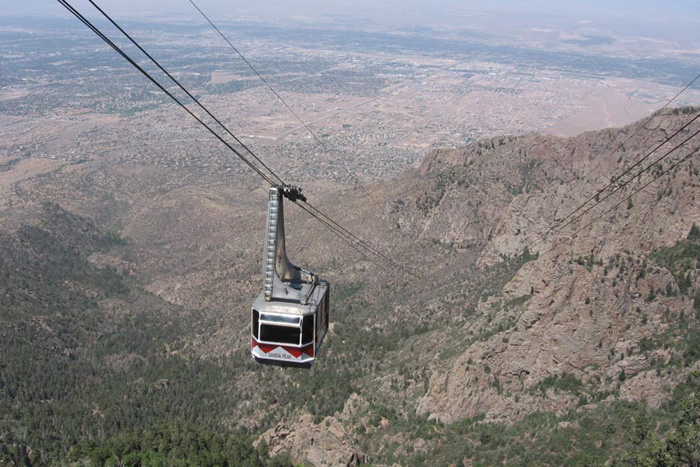Sandia at its Peak

The Sandia Park Tram, the longest aerial tram in the world, ascends the mountains for which the Woodwards named their foundation.
Alumni couple's generosity lends tuition relief to students in central Pennsylvania—and the Southwest
If you visit Albuquerque you can’t help but be drawn to the Sandia Mountains. The color of watermelon at sunset, as the Spanish name implies, they provide a spectacular eastern backdrop to the city’s growing sprawl.
Years ago, when this Southwestern capital was smaller and more serene, Helen Kisner Woodward, class of 1908, loved to sit gazing at the mountains from the living-room window of her modest home on Sigma Chi Road, a block from the University of New Mexico campus. Reserved, shy and frugal, she and her astute businessman husband Hugh, class of 1908, left an outsized legacy through a foundation that has provided, in the last four decades, $33 million in scholarship grants for Dickinson students and a like amount to University of New Mexico students.
The foundation, which the childless couple named for their 10,000-foot-high local landmark, is one of the more unusual endowment funds in higher education, for it benefits not only a private, liberal-arts college in small-town Pennsylvania but the public University of New Mexico with 26,000 students on its main campus in the heart of a city of 700,000 residents.
Bringing two such diverse institutions together as beneficiaries—each gets 45 percent of the foundation’s yearly net income, while 10 percent goes to Albuquerque-area charities—was a visionary move fueled by the considerable fortune amassed by Hugh Woodward, a lawyer and conservative Republican who was lieutenant governor of New Mexico in the late 1920s. He also was an avid conservationist who served on the board of the National Wildlife Federation.
On his neatly typed five-page resumé Woodward proudly listed his membership in Dickinson’s Sigma Alpha Epsilon fraternity and Phi Beta Kappa Society, as well as the honorary doctor of laws he received in 1959. The college further honored the Woodwards by naming Kisner-Woodward Hall for them in 1969, one year after Hugh’s death and five years before Helen’s.
Ironically, Helen lived to be nearly 90. They had moved from their native Pennsylvania to Colorado in 1913, due to Helen’s ill health—she had tuberculosis. According to Rod Pera ’62, a Sandia Foundation board member since 1995, Woodward was a rancher in Clayton, N.M., until a big snowstorm wiped out all his cattle. The Woodwards pulled up stakes and moved to Albuquerque in 1929. Anticipating the city’s boom, he began snapping up real estate on what was then the outskirts but now is center city.
Leasing of its 80 parcels of land, which include office buildings, shopping centers, car dealerships and warehouses, so says Pera, remain the core of the Sandia Foundation’s assets, though it also has moved into security investments in recent years.
The Woodwards, who loved their alma mater, also felt close to the University of New Mexico, due to Hugh’s service on that board and their proximity to campus, notes John Perovich, who met the Woodwards in 1950 and has served on the foundation board since 1960—as chair for the last 40 years.
Pera retired as a Harrisburg attorney whose firm represented Dickinson, and moved to New Mexico in 1994. He promptly was invited to join the Sandia board, which requires that its members be a mix of Dickinson and University of New Mexico representatives. Vice President and Treasurer Annette Smith Parker ’73 is the other Dickinson member of the board, which meets monthly by telephone and holds four formal meetings a year, one of which is in Carlisle. Frequent interaction by the volunteer members “keeps all of us apprised of issues on the table and deals coming up,” Pera explains.
Their strategies are undeniably effective, as the foundation assets have grown from $8 million in 1974 to its present $85 million. “Last year we gave away $1.5 million each to Dickinson and the university and $302,000 to charities, such as the Red Cross, local schools, the homeless and people with disabilities,” says Pera.
Funds, like those provided by Sandia for scholarships and endowment, “are how we keep down the price of tuition, which is $44,000,” says Parker. “Families are paying this much—before financial aid—but it’s not the total cost of a year’s education at Dickinson. That’s really more than $55,000 per year.”
While the foundation’s real-estate acquisitions have been limited to Albuquerque, Pera says it is hoping to look East. “We don’t know the market as well in Carlisle, but we would love to get involved with it.”
The foundation also is working more strenuously to forge connections between the two institutions. “The University of New Mexico has a noted Southwest archaeology program,” notes Perovich, a president emeritus of that institution. “Some students from Carlisle could come here to be engaged in Southwest archaeology, and University of New Mexico students could participate in Dickinson’s dig [in Mycenae, Greece]. We’ve also talked about exchanges in Native American cultural studies.”
With exciting partnerships beckoning, board members find the work invigorating and are proud to have fulfilled the Woodwards’ wishes.
Says Pera, “Both institutions have been very appreciative and used the funds for the benefit of students, and that’s what Mr. and Mrs. Woodward would have wanted.”
Published July 3, 2008